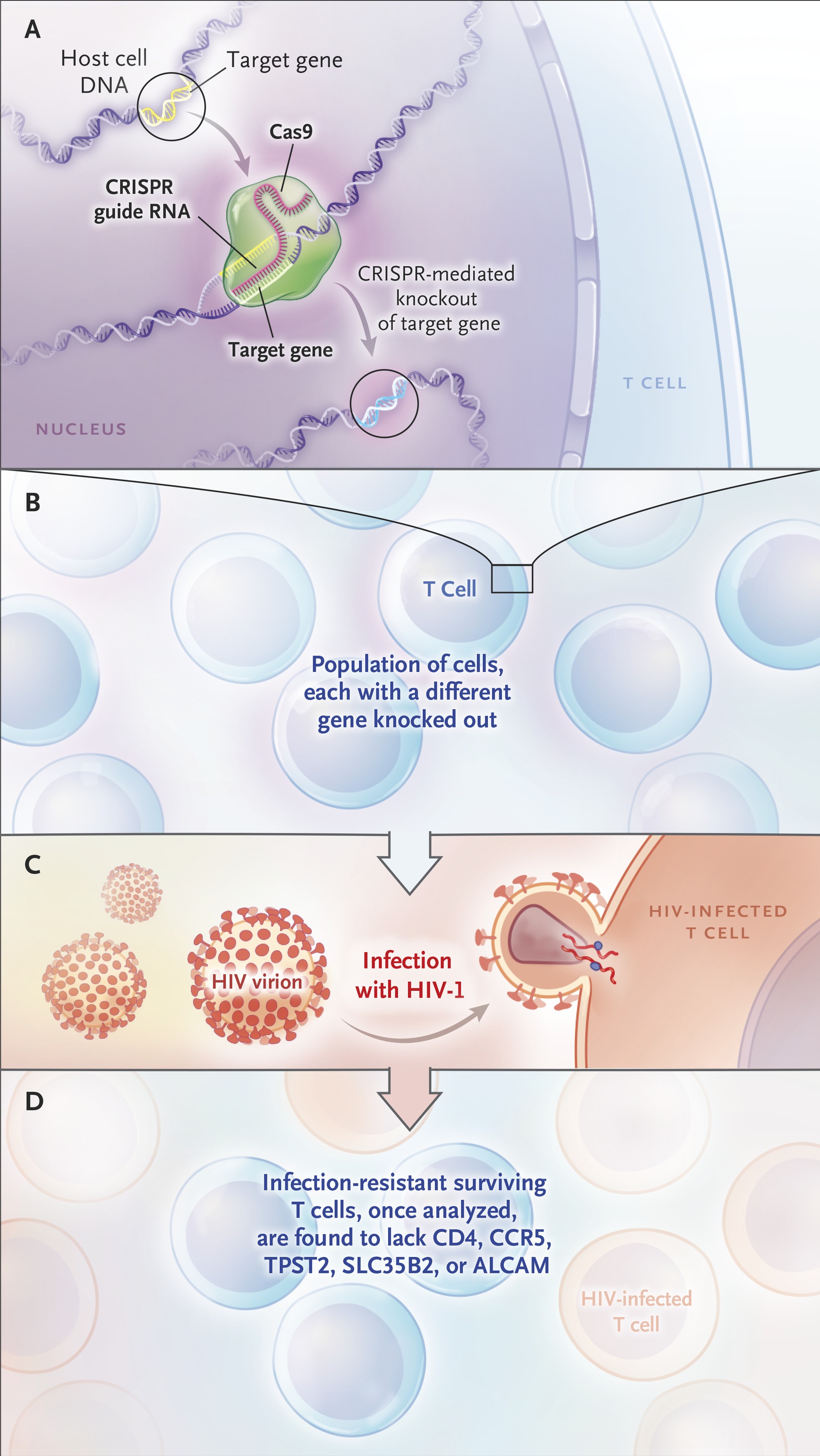An ongoing dialogue on HIV/AIDS, infectious diseases,
December 2nd, 2018
As A Strategy for HIV Prevention, Disabling the CCR5 Gene in Embryos Implanted in HIV-Negative Mothers Makes Zero Sense

The CRISPR Way to Identify Proteins Essential to HIV-1 Infection. From N Engl J Med 2017; 376:1290-1291.
One of the great joys of being an ID/HIV specialist is looking back at how far we’ve come in HIV prevention and treatment since the beginning of the epidemic.
Here are a bunch of things we know about HIV prevention, listed roughly in order of when we learned them — and forgive me if this is an oversimplification for this sophisticated readership:
- Condoms work very well in preventing HIV transmission.
- Taking a brief course of HIV therapy soon after exposure reduces the risk of HIV acquisition.
- Babies born to HIV-positive mothers do not contract HIV if the moms take suppressive HIV therapy.
- Male circumcision reduces the risk of these men acquiring HIV.
- People do not contract HIV from their HIV-positive partners if the person with HIV takes suppressive HIV therapy.
- People taking pre-exposure prophylaxis markedly reduce their risk for HIV acquisition.
You’ll note that nowhere on this list is anything about preventing HIV in babies born to women who don’t have the virus to begin with — because the babies are not at risk, even if the mother’s male sexual partner has HIV.
Just typing that sentence felt a little strange, it’s so obvious. However, it seems that He Jiankui may not understand this basic fact.
He’s the scientist who startled the world by releasing news that he and his research team had used CRISPR–Cas9 genome-editing to alter the embryos of two babies. The editing disabled the CCR5 gene, which means the babies lack a key co-receptor that HIV uses to infect cells.
However, as noted at 1:53 in the above-linked video, it’s the father who has HIV. Indeed, reports indicate that eight serodiscordant couples have participated in his studies — all with the fathers having HIV.
I’ll let others with far greater knowledge of genetics, embryology, and medical ethics comment on just how reckless this experiment was — here’s a good take (there have been many).
But from an HIV prevention perspective, it’s easy to judge — it makes zero sense to do this since the babies aren’t at risk of getting HIV to begin with. For them and their families, the genome-editing was all risk and no reward.
Let’s hope the mothers understood this before they agreed to participate in this disturbing experiment.


CRISPR technology frightens me for two reasons. First, I don’t think we’ll ever know enough to use the technology safely. The Law of Unintended Consequences will never be repealed. CRISPR will be used first for disease prevention and treatment. Even if it were used only for this purpose, we cannot know what the long-term consequences will be until we study the generations that will come from those whose genome has been altered. We cannot know what these unintended consequences will be until we have already used the technique. I do not understand how any testing will ever be able to prove the technique is without harm before we use it. Of course, we do that all the time with drugs, only learning of their side-effects when more people have received them. The big difference, though, is that a unexpected drug side effect is confined to the person who took the drug. CRISPR changes the equation so that the offspring of the person who had CRISPR done to their genome will be the potential affected person.
Second, CRISPR or a technique like it will be used to design babies to set specifications of height, IQ, athletic ability, eye color, and so forth. Used this way CRISPR has the potential to change what it means to be human. Our children, instead of being accepted as gifts, will become just something else that is manufactured. What will the parents of a CRISPR child do when they get the equivalent of an automotive lemon? I fear CRISPR scientists and advocates are creating an equivalent to the Tower of Babylon, crossing a line that should never be crossed.
Very interesting. Im glad we are pointing out the problems with not performing useless procedures and protecting people.
Agree. But, I believe he was not trying to prevent vertical transmission. But rather, he was trying to make the children resistant to horizontal transmission in the future.
I wonder.
Can this be done to create adult humans who would be resistant
to HIV virus when these babies are adult later?
We have
– condoms,
– TasP,
– Test and Treat,
– PrEP,
– HIV cure work which has yet to find the so-called holy grail of shocking and waking up the latently infected cells.
Yet, we are still seeing HIV infections happening esp. amongst the marginalized populations.
Helmi, thats absolutely true! We can have all the best stradegies for prevention, but as long as social problems (violence, inequity, less education, poverty etc) are not solved HIV will still be present in our world. Thanks for this comment Dr. Sax
I agree that the gene editing was likely done to prevent the child from being infected as an adult. This could then result in an adult who carries HIV, and passes on HIV, without getting infected, herself. This is an irresponsible scenario. If this were the goal, it is still a shortsighted and unethical procedure.
Even if the CCR5 gene is eliminated, wouldn’t horizontal transmission be possible with the other co-receptor (CXCR5)?
Did this study get IRB Approval? The procedures are unfair to the HIV unexposed baby